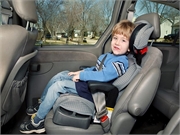FRIDAY, Sept. 4, 2020 (HealthDay News) — Face masks and hand-washing are a good start, but to protect your kids from the coronavirus you’ll need to up your game on the road, too, a leading pediatricians’ group says.
There are a number of things parents should do to protect children from COVID-19 infection when they’re traveling in cars or using other types of transportation, according to the American Academy of Pediatrics (AAP).
As always, children in vehicles should be properly restrained in an appropriate car safety seat, belt-positioning booster seat, travel vest or seat belt.
The U.S. Centers for Disease Control and Prevention recommends that surfaces be disinfected. However, disinfectant chemicals can weaken the strength of car safety seats and seat belts, possibly affecting their effectiveness in a crash, according to the academy.
In most cases, all parts of car safety seats and vehicle seat belts can only be cleaned with mild detergent and water.
Because car safety seats and seat belts can’t be disinfected, you should take other measures to prevent transmission of the coronavirus when children are in vehicles, the AAP advised.
Those precautions include: physical/social distancing; using cloth face coverings; and hand hygiene. Parents and caregivers of children with special needs (such as compromised immune systems, tracheostomy tubes, or use of a wheelchair) must take the child’s specific needs into account when developing a transportation plan, the academy said in a news release.
Here are some other guidelines from the pediatricians’ group:
- If a car safety seat or seat belt is always used by the same person and no one else, and the person doesn’t have symptoms of COVID-19, routine cleaning is appropriate.
- If an adult or child has tested positive for the new coronavirus, clean any seat or restraint device that the person had contact with or was within 6 feet of. Vehicle seats may be disinfected. Remove car safety seats from the vehicle and store out of reach or in a securely tied plastic bag for a few days, after which you may clean and use them again.
- If an infected person used a seat belt, avoid using that seat position for a few days. After that, the seat and seat belt may be cleaned and used again. If you have another vehicle available, consider using it during this period.
- Use public transit sparingly and only if necessary. All riders should practice physical distancing, wear cloth face coverings, and use hand sanitizer often. For added safety, passengers may consider wearing eye protection.
More information
The U.S. Centers for Disease Control and Prevention has more on COVID-19 protection.
Copyright © 2024 HealthDay. All rights reserved.

